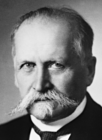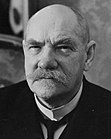
Kyösti Kallio was a Finnish politician who served as the fourth president of Finland from 1937 to 1940. His presidency included leading the country through the Winter War; while he relinquished the post of commander-in-chief to Carl Gustaf Emil Mannerheim, he played a role as a spiritual leader. After the war, he became both the first President of Finland to resign and the only one to die in office, dying of a heart attack while returning home after submitting his resignation.

Lauri Kristian Relander was the second president of Finland (1925–1931). A prominent member of the Agrarian League, he served as a member of Parliament, and as Speaker, before his election as President.

Kaarlo Juho Ståhlberg was a Finnish jurist and academic who was one of the most important pioneers of republicanism in the country. He was the first president of Finland (1919–1925) and a liberal nationalist.

The Centre Party, officially the Centre Party of Finland, is an agrarian-centrist political party in Finland. Ideologically, the Centre Party is positioned in the centre on the political spectrum. It has been described as liberal, social-liberal, liberal-conservative, and conservative-liberal. The party’s leader is Annika Saarikko, who was elected in September 2020 to follow Katri Kulmuni, the former finance minister of Finland. As of December 2019, the party has been a coalition partner in the Marin Cabinet, led by Prime Minister Sanna Marin of the Social Democratic Party (SDP).
Parliamentary elections were held in the Grand Duchy of Finland on 1 and 2 July 1908.
Parliamentary elections were held in Finland between 1 and 3 July 1922. The Social Democratic Party remained the largest in Parliament with 53 of the 200 seats. The caretaker government of Professor Aimo Cajander (Progressive), that President Kaarlo Juho Ståhlberg had appointed in June 1922, following the resignation of Prime Minister Juho Vennola (Progressive), remained in office until Kyösti Kallio formed an Agrarian-Progressive minority government in November 1922. Voter turnout was 58.5%.
Parliamentary elections were held in Finland on 1 and 2 April 1924. Although the Social Democratic Party remained the largest in Parliament with 60 of the 200 seats, Lauri Ingman of the National Coalition Party formed a centre-right majority government in May 1924. It remained intact until the Agrarians left in November 1924. Voter turnout was 57.4%.
Parliamentary elections were held in Finland on 1 and 2 July 1927. Although the Social Democratic Party remained the largest in Parliament with 60 of the 200 seats, Juho Sunila of the Agrarian League formed an Agrarian minority government in December 1927. It remained intact until December 1928. Voter turnout was 55.8%.
Parliamentary elections were held in Finland on 1 and 2 July 1929. The result was a victory for the Agrarian League, which won 60 of the 200 seats in Parliament. Voter turnout was 55.6%.
Parliamentary elections were held in Finland on 1 and 2 October 1930. The Social Democratic Party emerged as the largest in Parliament with 66 of the 200 seats. Voter turnout was 65.9%.
Parliamentary elections were held in Finland between 1 and 3 July 1933. The Social Democratic Party remained the largest party in Parliament with 78 of the 200 seats. However, Prime Minister Toivo Mikael Kivimäki of the National Progressive Party continued in office after the elections, supported by Pehr Evind Svinhufvud and quietly by most Agrarians and Social Democrats. They considered Kivimäki's right-wing government a lesser evil than political instability or an attempt by the radical right to gain power. Voter turnout was 62.2%.
Parliamentary elections were held in Finland on 1 and 2 July 1936. Following the election Prime Minister Toivo Mikael Kivimäki of the National Progressive Party was defeated in a confidence vote in September 1936 and resigned in October. Kyösti Kallio of the Agrarian League formed a centrist minority government after Pehr Evind Svinhufvud refused to allow the Social Democrats to join the government. After Svinhufvud's defeat in the February 1937 presidential election, Kallio took office as the new President in March 1937, and he allowed the Social Democrats, Agrarians and Progressives to form the first centre-left or "red soil" Finnish government. Aimo Cajander (Progressive) became Prime Minister, although the real strong men of the government were Finance Minister Väinö Tanner and Defence Minister Juho Niukkanen (Agrarian).

Indirect presidential elections were held for the first time in Finland in 1919. Although the country had declared Prince Frederick Charles of Hesse king on 9 October 1918, he renounced the throne on 14 December. The president was elected by Parliament, with Kaarlo Juho Ståhlberg of the National Progressive Party receiving 71.5% of the 200 votes.
Two-stage presidential elections were held in Finland in 1925. On 15 and 16 January the public elected presidential electors to an electoral college. They in turn elected the president. The result was a victory for Lauri Kristian Relander, who won on the third ballot. The turnout for the popular vote was just 39.7%. The outgoing president, K.J. Ståhlberg, had refused to seek a second term. According to the late Agrarian and Centrist politician, Johannes Virolainen, he stepped down after one term because he believed that an incumbent president would be too likely to win re-election. President Ståhlberg claimed that he had already completed his political service to Finland as president. Moreover, he wanted to step down because many right-wing Finns opposed him. According to Pentti Virrankoski, a Finnish historian, President Ståhlberg hoped that his retirement would advance parliamentary politics in Finland. Ståhlberg's party, the Progressives, chose Risto Ryti, the governor of the Bank of Finland, as their presidential candidate. The Agrarians only chose Lauri Kristian Relander as their presidential candidate in early February 1925. The National Coalitioners originally chose former Regent and Prime Minister Pehr Evind Svinhufvud as their presidential candidate, but before the presidential electors met, they replaced Svinhufvud with Hugo Suolahti, an academician working as the rector (principal) of the University of Helsinki. Relander surprised many politicians by defeating Ryti as a dark-horse presidential candidate, although he had served as the Speaker of the Finnish Parliament, and as Governor of the Province of Viipuri. Ståhlberg had quietly favoured Ryti as his successor, because he considered Ryti a principled and unselfish politician. He was disappointed with Relander's victory, and told one of his daughters that if he had known beforehand that Relander would be elected as his successor, he would have considered seeking a second term.

Two-stage presidential elections were held in Finland in 1931. On 15 and 16 January the public elected presidential electors to an electoral college. They in turn elected the President.The result was a victory for Pehr Evind Svinhufvud, who won on the third ballot by just two votes. The turnout for the popular vote was 47.3%.
Two-stage presidential elections were held in Finland in 1950, the first time the public had been involved in a presidential election since 1937 as three non-popular elections had taken place in 1940, 1943 and 1946. On 16 and 17 January the public elected presidential electors to an electoral college. They in turn elected the President. The result was a victory for Juho Kusti Paasikivi, who won on the first ballot. The turnout for the popular vote was 63.8%. President Paasikivi was at first reluctant to seek re-election, at least in regular presidential elections. He considered asking the Finnish Parliament to re-elect him through another emergency law. Former President Ståhlberg, who acted as his informal advisor, persuaded him to seek re-election through normal means when he bluntly told Paasikivi: "If the Finnish people would not bother to elect a President every six years, they truly would not deserve an independent and democratic republic." Paasikivi conducted a passive, "front-porch" style campaign, making few speeches. By contrast, the Agrarian presidential candidate, Urho Kekkonen, spoke in about 130 election meetings. The Communists claimed that Paasikivi had made mistakes in his foreign policy and had not truly pursued a peaceful and friendly foreign policy towards the Soviet Union. The Agrarians criticized Paasikivi more subtly and indirectly, referring to his advanced age, and speaking anecdotally about aged masters of farmhouses, who had not realized in time that they should have surrendered their houses' leadership to their sons. Kekkonen claimed that the incumbent Social Democratic minority government of Prime Minister K.A. Fagerholm had neglected the Finnish farmers and the unemployed. Kekkonen also championed a non-partisan democracy that would be neither a social democracy nor a people's democracy. The Communists hoped that their presidential candidate, former Prime Minister Mauno Pekkala, would draw votes away from the Social Democrats, because Pekkala was a former Social Democrat. The Agrarians lost over four per cent of their share of the vote compared to the 1948 parliamentary elections. This loss ensured Paasikivi's re-election. Otherwise Kekkonen could have been narrowly elected President - provided that all the Communist and People's Democratic presidential electors would also have voted for him.

Early and indirect presidential elections were held in Finland in 1940 after President Kyösti Kallio resigned on 27 November following a stroke on 27 August. The 1937 electoral college was recalled and elected Prime Minister Risto Ryti, who received 288 of the 300 votes. Most other Finnish politicians considered Ryti a principled, unselfish, intelligent and patriotic man, who could lead Finland effectively enough during World War II. His leadership qualities had been tested already during the Winter War. Also the outgoing President Kallio considered him the best available presidential candidate. In early December 1940, the Soviet Foreign Minister, Vyacheslav Molotov, interfered with the Finnish presidential elections by claiming to the Finnish Ambassador to the Soviet Union, Juho Kusti Paasikivi, that if potential presidential candidates such as Marshal Carl Gustaf Emil Mannerheim, former President Pehr Evind Svinhufvud, or former Prime Minister Toivo Mikael Kivimäki were elected President, the Soviet government would consider Finland unwilling to fulfill its peace treaty with the Soviet Union. Due to the lingering threat of another war and the Karelian refugees' dispersal throughout Finland, regular presidential elections were cancelled, and instead the 1937 presidential electors were summoned to elect the President. Under these tense political circumstances, Ryti had no problem winning these exceptional presidential elections by a landslide. The same day, former president Kallio died.

Two-stage presidential elections were held in Finland in 1956. On 16 and 17 January the public elected presidential electors to an electoral college. They in turn elected the President.
Two-stage presidential elections were held in Finland in 1968. On 15 and 16 January the public elected presidential electors to an electoral college. They in turn elected the President. The result was a victory for Urho Kekkonen, who won on the first ballot. The turnout for the popular vote was 70%.












